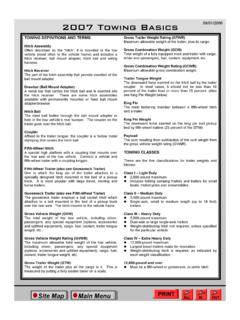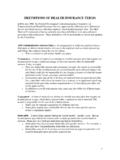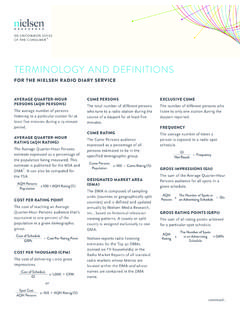Transcription of Understanding the Terms and Definitions of LDO …
1 Application Report SLVA079 - October 1999. Understanding the Terms and Definitions of LDO Voltage Regulators Bang S. Lee Mixed Signal Products ABSTRACT. This report provides an Understanding of the Terms and Definitions of low dropout (LDO). voltage regulators, and describes fundamental concepts including dropout voltage, quiescent current, standby current, efficiency, transient response, line/load regulation, power supply rejection, output noise voltage, accuracy, and power dissipation. Each section includes an example to increase the understandability. Contents 1 Dropout Voltage .. 2. 2 Quiescent Current .. 3. 3 Standby Current .. 3. 4 Efficiency .. 4. 5 Transient Response .. 5. 6 Line Regulation .. 5. 7 Load Regulation .. 6. 8 Power Supply Rejection .. 7. 9 Output Noise Voltage .. 8. 10 Instability of LDO Regulator .. 9. 11 Accuracy .. 10. 12 Power Dissipation and Junction Temperature .. 11. 13 Summary .. 12. List of Figures 1 Typical Application Circuit of LDO Regulator .. 2. 2 Dropout Region of TPS76733 ( V LDO).
2 2. 3 Quiescent Current of LDO Regulator .. 3. 4 Standby Current of LDO Regulator .. 4. 5 Transient Response of , 100 mA LDO Regulator .. 5. 6 Transient Response of TPS76933 .. 6. 7 TPS76933 Output Voltage With Respect to the Input Voltages .. 6. 8 Load Transient Response of TPS76350 .. 7. 1. SLVA079. 9 TPS76350 LDO Regulator Output Voltage With Respect to Output Currents .. 7. 10 Power Supply Rejection .. 8. 11 Output Noise Voltage .. 9. 12 Stable Range of CSR .. 9. 13 LDO Regulator .. 10. 14 Power Dissipation vs Output Current .. 11. 1 Dropout Voltage Dropout voltage is the input-to-output differential voltage at which the circuit ceases to regulate against further reductions in input voltage; this point occurs when the input voltage approaches the output voltage. Figure 1 shows a typical LDO regulator circuit. In the dropout region, the PMOS pass element is simply a resistor, and dropout is expressed in Terms of its on-resistance (Ron). V. dropout + IoRon (1). + V dropout _. Ii Io IN OUT +.
3 LDO. Co Vi Vo GND. CSR Dropout Voltage: V dropout =Io XR on _. Figure 1. Typical Application Circuit of LDO Regulator For example, Figure 2 shows the input/output characteristics of the TPS76733 LDO. regulator. The dropout voltage of the TPS76733 is typically 350 mV at 1 A. Thus, the LDO. regulator begins dropping out at input voltage; the range of the dropout region is between approximately 2-V and input voltage. Below this, the device is nonfunctional. Low dropout voltage is necessary to maximize the regulator efficiency. dropout region output voltage Vo [V]. off regulation region region dropout voltage 0 10. input voltage Vi [V]. Figure 2. Dropout Region of TPS76733 ( V LDO). 2 Understanding the Terms and Definitions of LDO Voltage Regulators SLVA079. 2 Quiescent Current Ii Io IN OUT. +. LDO. Co Vi Vo GND. CSR _. Quiescent Current:: Iq I q = I i Io Figure 3. Quiescent Current of LDO Regulator Quiescent, or ground current, is the difference between input and output currents. Low quiescent current is necessary to maximize the current efficiency.
4 Figure 3 shows the quiescent current that is defined by Iq + Ii * Io (2). Quiescent current consists of bias current (such as band-gap reference, sampling resistor, and error amplifier currents) and the gate drive current of the series pass element, which do not contribute to output power. The value of quiescent current is mostly determined by the series pass element, topologies, ambient temperature, etc. For bipolar transistors, the quiescent current increases proportionally with the output current, because the series pass element is a current-driven device. In addition, in the dropout region the quiescent current can increase due to the additional parasitic current path between the emitter and the base of the bipolar transistor, which is caused by a lower base voltage than that of the output voltage. For MOS transistors, the quiescent current has a near constant value with respect to the load current since the device is a voltage-driven device. The only things that contribute to the quiescent current for MOS transistors are the biasing currents of band gap, sampling resistor, and error amplifier.
5 In applications where power consumption is critical, or where small bias current is needed in comparison with the output current, an LDO voltage regulator using MOS transistors is essential. 3 Standby Current Standby current is the input current drawn by a regulator when the output voltage is disabled by a shutdown signal. The reference and the error amplifier in an LDO regulator are not loaded during the standby mode, as shown in Figure 4. Understanding the Terms and Definitions of LDO Voltage Regulators 3. SLVA079. EN (high). +. Is +. V CC V CC. Vi V ref V o =0[V]. Reference . +. GND .. Standby current = I s when output is disabled Switch positions are shown with EN high (standby mode). Figure 4. Standby Current of LDO Regulator 4 Efficiency The efficiency of LDO regulators is limited by the quiescent current and input/output voltages as follows. + ) . I oV o Efficiency 100 (3). Io Iq V. i To have a high efficiency, drop out voltage and quiescent current must be minimized. In addition, the voltage difference between input and output must be minimized, since the power dissipation of LDO regulators accounts for the efficiency.
6 (Power Dissipation = (Vi Vo)Io). The input/output voltage difference is an intrinsic factor in determining the efficiency, regardless of the load conditions. Example: 1. What is the efficiency of the TPS76933 LDO regulator with the following operating conditions? Input voltage range is V to V. Output current range is 80 mA to 100 mA. The maximum quiescent current is 17 A. Then, the minimum efficiency is obtained as follows: + (100100 mA @ V 100 + %. mA ) 17 A) V. Efficiency 2. What is the efficiency if input voltage range is V to 4 V under the same conditions as the above? The minimum efficiency is improved as follows: Efficiency + (100100mAmA) A)4. V. V. 100 + %. 4 Understanding the Terms and Definitions of LDO Voltage Regulators SLVA079. 5 Transient Response The transient response is the maximum allowable output voltage variation for a load current step change. The transient response is a function of the output capacitor value (Co), the equivalent series resistance (ESR) of the output capacitor, the bypass capacitor (Cb) that is usually added to the output capacitor to improve the load transient response, and the maximum load-current (Io,max).
7 The maximum transient voltage variation is defined as follows: DVtr,max + C o,max ) C Dt1 ) DVESR. I. (4). o b Where t1 corresponds to the closed loop bandwidth of an LDO regulator. VESR is the voltage variation resulting from the presence of the ESR (RESR) of the output capacitor. The application determines how low this value should be. Ii Io IN OUT. +. LDO C o=. Load Vi Vo GND Cb ESR. V tr,max t1. Figure 5. Transient Response of , 100 mA LDO Regulator Figure 5 shows the transient response of a V, 100-mA LDO regulator with an output capacitor of F. A step change of load current (near 90 mA) was applied to the regulator, which is shown in the upper trace of the figure. In the lower trace the output voltage drops approximately 120 mV and then the voltage control loop of the LDO regulator begins to respond to the step load change within 1 us ( t1 = 1 s). The frequency bandwidth of the LDO regulator accounts for t1. Finally, the output voltage reaches a stable state within 17 s. To obtain a better transient response, a higher bandwidth of the LDO regulator, higher values of output/bypass capacitors, and low ESR values are recommended, provided they meet the CSR.
8 Requirements. 6 Line Regulation Line regulation is a measure of the circuit's ability to maintain the specified output voltage with varying input voltage. Line regulation is defined as Line regulation + DDVVo (5). i Understanding the Terms and Definitions of LDO Voltage Regulators 5. SLVA079. Ii Io IN OUT. +. LDO Load Vo Vi GND. ESR.. Change of Input Resultant Voltage Output Voltage Output Voltage 7. Input Voltage VLR2. 6. [V]. [V]. 5 VL R1. 0 50 100 150 0 50 100 150. Time [us] Time [us]. Figure 6. Line Transient Response of TPS76933. Figure 6 shows the input voltage transient response of the TPS76933 LDO regulator. A. step change of input voltage was applied to the regulator, which is shown at the lower left in the figure. The resultant output voltage has been changed due to the different input voltages as shown in the right side of the figure. The line regulation is determined by VLR1 and VLR2 since line regulation is a steady-state parameter ( , all frequency components are neglected).
9 Figure 7 shows the circuit performance of the TPS76933 LDO regulator with respect to the input voltages. The broken line shows the range of the output voltage variation ( VLR) resulting from the input voltage change. Increasing open loop gain improves the line regulation. Output Voltage V o [V}. Output Voltage Variation 0 10. Input Voltage VI [V]. Figure 7. TPS76933 Output Voltage With Respect to the Input Voltages 7 Load Regulation Load regulation is a measure of the circuit's ability to maintain the specified output voltage under varying load conditions. Load regulation is defined as DVo (6). Load regulation;. DIo 6 Understanding the Terms and Definitions of LDO Voltage Regulators SLVA079. Ii Io IN OUT. +. LDO Load Vo Vi GND. ESR.. Step Change of Resultant Load Current Output Voltage Output Voltage 200. Output Current Vo [V]. I o [mA]. 100 V LDR. 0 0 50 100 150 0 50 100 150. Time [us] Time [us]. Figure 8. Load Transient Response of TPS76350. The worst case of the output voltage variations occurs as the load current transitions from zero to its maximum rated value or vice versa, which is illustrated in Figure 8.]
10 The load regulation is determined by the VLDR since load regulation is a steady-state parameter like the line regulation. Figure 9 shows the circuit performance of the TPS76350 5-V LDO regulator with respect to the output currents. Increasing open loop gain improves the load regulation. Output Voltage V o [V]. 5. 5. 0 30 60 90 120 150 180. Output Current Io [mA]. Figure 9. TPS76350 LDO Regulator Output Voltage With Respect to Output Currents 8 Power Supply Rejection Power supply rejection ratio (PSRR), also known as ripple rejection, measures the LDO. regulator's ability to prevent the regulated output voltage fluctuating caused by input voltage variations. The same relation for line regulation applies to PSRR except that the whole frequency spectrum is considered. Understanding the Terms and Definitions of LDO Voltage Regulators 7. SLVA079. + IN OUT +. Vi LDO Vo Co Vi Vo Vo, ripple V i,ripple GND. Cb CSR. 0 time 0 time _ _. Ripple Rejection: Vo, ripple PSRR = at all frequencies V i,ripple 0.















